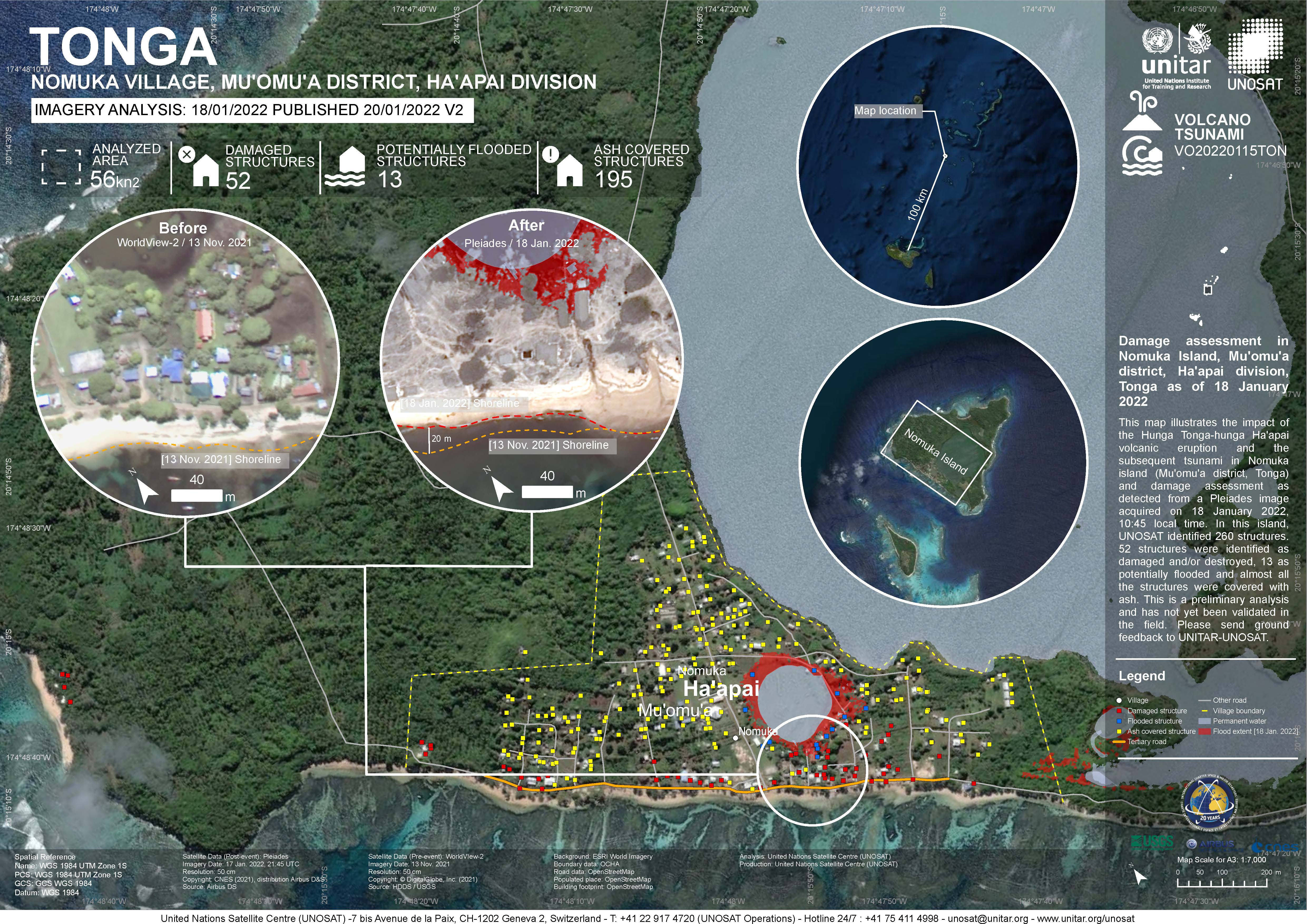FAO Agriculture and Fair Trade in Pacific Island Countries. This desk study has been prepared by Winnie Fay Bell and comments were kindly provided by the Pacific Regional Organic Task Force in May 2009
The increased demand for high quality products in export markets, coupled with Pacific Island Countries (PICs) national desire to protect the environment, biodiversity and family farming structures, lead to assume that organic agriculture could offer good prospects for PICs development. Besides market opportunities, organic agriculture could increase PICs food self-reliance and thus, contribute to reducing the alarming trend of dependency on food imports, as well as improving nutrition.
Damage assessment as detected from a Pleiades image acquired on 18 January 2022 in Nomuka Island (Mu'omu'a district, Tonga).
260 structures identified, 52 structures were identified as damaged and/or destroyed, 13 as potentially flooded and almost all structures were covered with ash. This is a preliminary analysis and has not yet been validated in the field

REPORT 2: RECOMMENDATIONS FOR STRENGTHENING THE ACTION STRATEGY AND ENHANCING ITS IMPLEMENTATION
2008-2012 Action Strategy For Nature Conservation Principles For Nature Conservation Progress Report
It is a 35 paged Evaluation Report on the 7th Pacific Islands Conference on Nature Conservation and Protected Areas event. This evaluation is the result of a questionnaire (Annex 5) handed out at the end of the conference with a 15.3% return rate (47 conference evaluations). The report's structure will be a planning tool for future conferences to measure and assess what worked and what didn’t work at the 7th Conference
In accordance with the precautionary approach contained in Principle 15 of the Rio Declaration on Environment and Development, the objective of this Protocol is to contribute to ensuring an adequate level of protection in the field of the safe transfer, handling and use of living modified organisms resulting from modern biotechnology that may have adverse effects on the conservation and sustainable use of biological diversity, taking also into account risks to human health, and specifically focusing on transboundary movements.
The Conference of the Parties (COP) agreed on a provisional list of global headline indicators, to assess progress at the global level towards the 2010 target (decision VII/30), and to effectively communicate trends in biodiversity related to the three objectives of the Convention. In decision VII/30 the COP established a process for testing and developing the indicators, with inputs from SBSTTA, the ad hoc Working Groups on ABS and Article 8(j), and an AHTEG on indicators for assessing progress towards the 2010 biodiversity target.
Pages 76-365 of the DECISIONS ADOPTED BY THE CONFERENCE OF THE PARTIES TO THE CONVENTION ON BIOLOGICAL DIVERSITY AT ITS EIGHTH MEETING 2006 Report. Meeting was held Curitiba, Brazil, 20-31 March 2006
DECISIONS ADOPTED BY THE CONFERENCE OF THE PARTIES TO THE CONVENTION ON BIOLOGICAL DIVERSITY AT ITS NINTH MEETING 2008
DRAFT FINDINGS OF THE AD HOC TECHNICAL EXPERT GROUP ON BIODIVERSITY AND CLIMATE CHANGE 2008 in London. THE SECOND AD HOC TECHNICAL EXPERT GROUP ON BIODIVERSITY AND CLIMATE CHANGE
CBD Goals and objectives of the Strategic Plan and provisional indicators for assessing progress 2010
Goals and Targets of the Programme of Work on Protected Areas
Goals, targets and timeframes, and island-specific priority actions for the Parties 2009
This document is a review of the status, trends and threats to Tonga’s unique biodiversity since the inception of its own NBSAP in 2006. The review also covers the status of the implementation of objectives and action plans, sectors and cross sector collaboration.